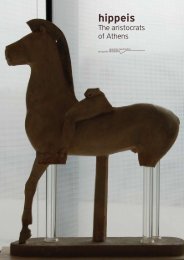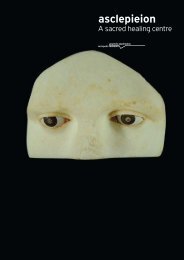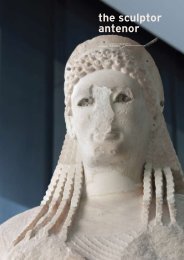The Parthenon Sculpture
The Parthenon Sculpture
The Parthenon Sculpture
Create successful ePaper yourself
Turn your PDF publications into a flip-book with our unique Google optimized e-Paper software.
6<br />
<strong>The</strong> <strong>Parthenon</strong><br />
<strong>The</strong> <strong>Parthenon</strong> was built between 447 and 438 B.C., by the architects Iktinos and Kallikrates.<br />
<strong>The</strong> famous sculptor Pheidias, a personal friend of Pericles, had general responsibility for<br />
supervising the entire project.<br />
It is a Doric temple with many Ionic features. It was made of white Pentelic<br />
marble, being some 70 meters long, 31 meters wide and 15 meters high.<br />
It is surrounded by a peristyle, having 8 columns across each narrow end<br />
and 17 columns along each of its long sides. <strong>The</strong> cella, the central<br />
closed part of the temple, was divided into two compartments<br />
which did not communicate with each other. <strong>The</strong> great,<br />
13 metres high, gold and ivory statue of<br />
the goddess Athena, famous<br />
work by Pheidias, was<br />
housed in the east<br />
compartment. A Doric,<br />
two-tiered colonnade enframed<br />
the statue. In the west compartment,<br />
there were 4 Ionic columns. <strong>The</strong> cella had in<br />
addition a second row of 6 Doric columns, east and<br />
west. <strong>The</strong> monument had in total 108 columns outside and inside.<br />
<strong>The</strong> richness of the sculptural decoration of the <strong>Parthenon</strong> was unique.<br />
<strong>The</strong>re are three basic sculptural groups: the pediments, the metopes and the frieze.






